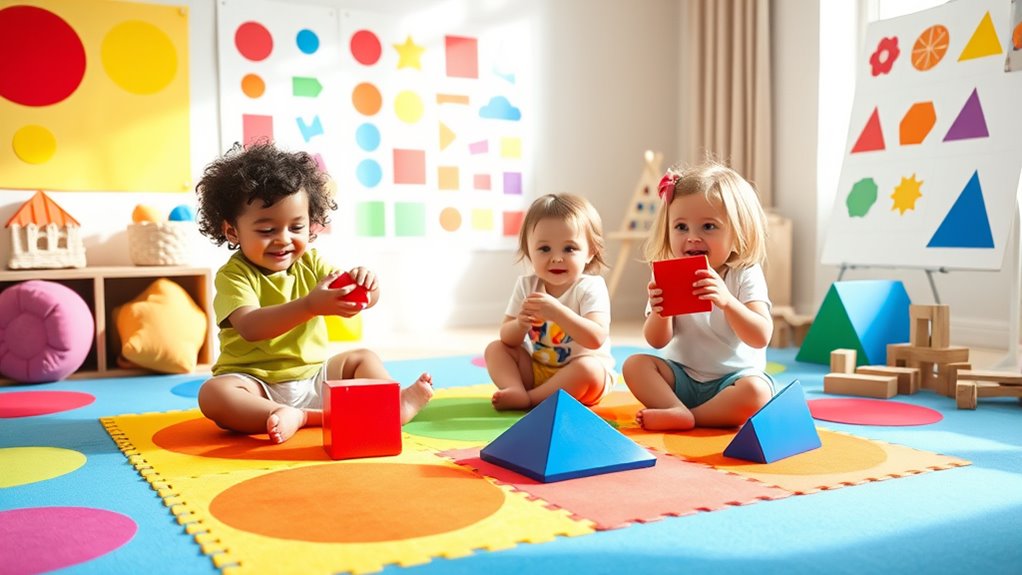To teach colors and shapes to toddlers aged 1 to 3, incorporate fun, multisensory activities like pointing out colorful objects, playing shape sorting games, and using engaging picture books. Encourage them to name and find specific colors and shapes in their environment, making learning playful and interactive. Repetition and visual aids help strengthen recognition and vocabulary. Keep exploring simple strategies—if you keep learning, you’ll find more effective ways to support their early development.
Key Takeaways
- Use colorful objects and playful activities like scavenger hunts to help toddlers recognize and name colors naturally.
- Incorporate shape sorters and DIY cutouts to develop shape recognition and fine motor skills in a fun way.
- Use flashcards and picture books with vibrant images to reinforce color and shape vocabulary through multisensory learning.
- Combine color and shape activities, prompting children to find objects matching specific attributes to enhance categorization skills.
- Apply visual aids, repetition, and age-appropriate methods to strengthen recognition, retention, and curiosity in early learning.
Engaging Activities for Teaching Colors and Shapes

Have you ever wondered how to make learning colors and shapes fun and engaging for your toddler? It’s easier than you might think when you incorporate playful, hands-on activities into your daily routine. Start with simple color recognition activities that capture your child’s interest. For example, gather objects of different colors—red apples, blue blocks, yellow bananas—and encourage your toddler to identify each one. You can also create a colorful scavenger hunt around the house or yard, asking your child to find something of a specific color. These activities help your little one associate words with visual cues, strengthening their understanding of colors in a natural, enjoyable way.
Next, introduce shape sorting games to build your toddler’s spatial awareness and problem-solving skills. Use a set of shape sorters or make your own with cardboard and various cutouts like circles, squares, triangles, and rectangles. As your child sorts the shapes into matching holes or containers, you’re reinforcing their recognition of different shapes and teaching them to differentiate one from another. Make it more engaging by turning it into a game—set a timer, or challenge them to sort the shapes faster each time. These shape sorting games are excellent for developing fine motor skills and hand-eye coordination, all while making the learning process feel like play rather than work. Incorporating multisensory learning techniques can further enhance their grasp of these concepts.
Incorporate colorful flashcards or picture books that showcase various shapes and colors to further reinforce what your toddler is learning. Point to each shape or color as you say the name aloud, encouraging your child to repeat after you. This multisensory approach helps solidify their understanding because they see, hear, and sometimes even touch the objects. To keep things interesting, you can also combine color recognition activities with shape sorting by asking your toddler to find objects that are both a certain color and shape. For instance, “Can you find a red circle?” This not only broadens their vocabulary but also enhances their ability to categorize objects based on multiple attributes. Additionally, exploring color and shape recognition through interactive games can boost their cognitive development even further. Recognizing the importance of educational strategies, such as repetition and multisensory engagement, can make learning more effective and enjoyable for your toddler. Incorporating visual aids, like charts and posters, can also provide consistent reinforcement and support their learning journey. Using age-appropriate teaching methods tailored to your child’s developmental stage can significantly improve their learning outcomes and keep them motivated to explore and learn.
Frequently Asked Questions
How Can I Teach Colors to Toddlers With Visual Impairments?
When teaching colors to toddlers with visual impairments, you can use tactile activities like textured objects and fabric swatches to help them feel different colors. Incorporate audio descriptions that clearly explain the colors and shapes, making the learning more accessible. You should also encourage exploration and repetition, allowing children to connect tactile sensations and audio cues with each color, fostering a multisensory learning experience that enhances understanding and engagement.
What Are Effective Methods for Teaching Shapes to Bilingual Children?
You can teach shapes to bilingual children effectively by using visual aids like flashcards and shape toys to reinforce understanding. Incorporate repetition strategies by regularly reviewing shapes in different contexts and languages, which helps solidify learning. Engage children with hands-on activities, encouraging them to identify and describe shapes in their environment. This approach supports bilingual learners in grasping shapes through visual cues and consistent practice.
How Do I Incorporate Technology Into Teaching Colors and Shapes?
Imagine transforming your lessons with a simple tap—how? By incorporating technology, you open endless possibilities. Use interactive apps that make learning colors and shapes engaging and fun. Digital storytelling adds a captivating narrative that holds their attention while teaching concepts. These tools not only enhance understanding but also foster curiosity. Embrace technology, and watch your toddlers enthusiastically explore, learn, and develop their skills in exciting new ways.
What Are Signs of Color or Shape Recognition Delays in Toddlers?
You should watch for signs of delays in color recognition milestones, like a toddler struggling to identify basic colors consistently. For shape identification signs, if they have difficulty naming simple shapes or matching shapes to objects, it could indicate a delay. Early signs include limited interest or inconsistent responses during activities. Recognizing these signs helps you seek support sooner, ensuring your child develops essential visual and cognitive skills effectively.
How Can I Adapt Activities for Toddlers With Developmental Disabilities?
You might find that adapting activities for toddlers with developmental disabilities involves incorporating sensory play and adaptive tools. Coincidentally, these methods often reveal surprising progress. Use textured materials or visual aids to engage their senses, making learning accessible. Adaptive tools like larger shape blocks or easy-grip crayons help them participate comfortably. Tailoring activities this way guarantees each child can explore colors and shapes at their own pace, fostering confidence and joy in learning.
Conclusion
By incorporating these playful activities, you turn learning into a vibrant journey that sparks curiosity and joy. Just as a rainbow paints the sky with endless possibilities, your involvement helps little ones see the world’s beauty through colors and shapes. Remember, each moment of exploration is a brushstroke in their development. So, embrace patience and creativity—because nurturing their curiosity today shapes the bright, colorful minds of tomorrow.










